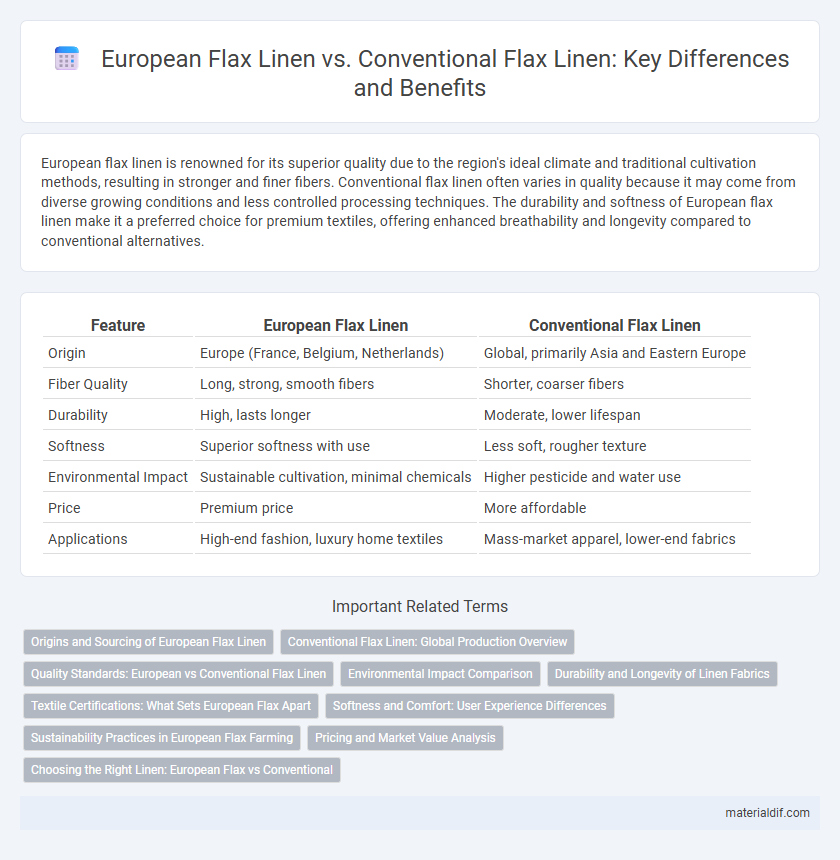European flax linen is renowned for its superior quality due to the region's ideal climate and traditional cultivation methods, resulting in stronger and finer fibers. Conventional flax linen often varies in quality because it may come from diverse growing conditions and less controlled processing techniques. The durability and softness of European flax linen make it a preferred choice for premium textiles, offering enhanced breathability and longevity compared to conventional alternatives.
Table of Comparison
| Feature | European Flax Linen | Conventional Flax Linen |
|---|---|---|
| Origin | Europe (France, Belgium, Netherlands) | Global, primarily Asia and Eastern Europe |
| Fiber Quality | Long, strong, smooth fibers | Shorter, coarser fibers |
| Durability | High, lasts longer | Moderate, lower lifespan |
| Softness | Superior softness with use | Less soft, rougher texture |
| Environmental Impact | Sustainable cultivation, minimal chemicals | Higher pesticide and water use |
| Price | Premium price | More affordable |
| Applications | High-end fashion, luxury home textiles | Mass-market apparel, lower-end fabrics |
Origins and Sourcing of European Flax Linen
European Flax Linen originates primarily from regions in France, Belgium, and the Netherlands, where optimal climate and soil conditions produce high-quality flax fibers. This linen is cultivated using traditional, sustainable farming practices that emphasize minimal pesticide use and eco-friendly harvesting methods. Sourcing European flax linen ensures superior fiber strength, durability, and a finer, smoother texture compared to conventional flax linen produced in other global regions.
Conventional Flax Linen: Global Production Overview
Conventional flax linen dominates global production due to its widespread cultivation in regions such as China, Russia, and Kazakhstan, which contribute significantly to the total flax fiber output. Traditional farming methods in these countries emphasize high-yield crop practices, leading to economies of scale but often involve greater use of pesticides and water compared to European flax linen. This large-scale production supports global demand for affordable linen textiles while influencing the environmental footprint of the flax linen supply chain.
Quality Standards: European vs Conventional Flax Linen
European flax linen is renowned for its superior quality standards, driven by stringent cultivation and processing regulations in countries like Belgium and France. These standards ensure finer fiber strength, enhanced durability, and a smoother texture compared to conventional flax linen, which often varies in quality due to less controlled growing environments. As a result, European flax linen is preferred in premium textile markets for its consistency, longevity, and refined aesthetic.
Environmental Impact Comparison
European Flax Linen demonstrates a significantly lower environmental footprint compared to conventional flax linen, primarily due to sustainable farming practices prevalent in Europe that reduce pesticide use and promote soil health. European flax cultivation typically uses less water and energy, alongside stringent environmental regulations that minimize pollution and greenhouse gas emissions. This results in a more eco-friendly linen production process, emphasizing resource efficiency and biodiversity preservation.
Durability and Longevity of Linen Fabrics
European flax linen is renowned for its superior durability and longevity due to the region's optimal climate and soil conditions, which yield longer, stronger fibers compared to conventional flax. The meticulous harvesting and retting processes employed in Europe enhance fiber strength, resulting in linen fabrics that resist wear and maintain structural integrity over time. Conventional flax linen, while still durable, often features shorter fibers and less consistent processing, leading to reduced lifespan and a tendency to degrade faster with frequent use.
Textile Certifications: What Sets European Flax Apart
European Flax Linen boasts stringent textile certifications such as OEKO-TEX Standard 100 and GOTS, ensuring eco-friendly cultivation and processing methods free from harmful chemicals. Conventional Flax Linen often lacks these certifications, resulting in variable sustainability and quality standards. These certifications not only guarantee safer textiles but also promote traceability and ethical sourcing, setting European Flax Linen apart in the market.
Softness and Comfort: User Experience Differences
European flax linen offers superior softness and enhanced comfort compared to conventional flax linen due to its fine fiber quality and traditional retting methods unique to Europe. The longer fibers and careful processing result in a smoother texture that feels more gentle against the skin, making European linen ideal for sensitive users. Conventional flax linen tends to be coarser, with a rougher hand feel that can reduce overall wearing comfort.
Sustainability Practices in European Flax Farming
European flax linen stands out for its sustainability practices, utilizing minimal water and chemical inputs compared to conventional flax farming. European growers often implement crop rotation and organic farming methods that enhance soil health and reduce environmental impact. This results in linen production with a lower carbon footprint and improved ecological balance.
Pricing and Market Value Analysis
European flax linen commands higher pricing due to superior fiber quality, sustainable cultivation, and stringent EU agricultural standards, enhancing its market value compared to conventional flax linen. The premium segment segments driven by luxury fashion brands often prefer European flax for its durability, softness, and eco-friendly credentials, resulting in increased demand and price premiums. Conversely, conventional flax linen, with less regulated growing practices and variable fiber consistency, holds lower market value, primarily serving mass-market textile and home furnishing industries.
Choosing the Right Linen: European Flax vs Conventional
European flax linen boasts superior fiber quality due to consistent climate conditions and traditional harvesting methods, resulting in stronger, finer, and more durable fabric compared to conventional flax linen. Its sustainable cultivation practices reduce chemical use, ensuring eco-friendly production with enhanced softness and natural luster. Selecting European flax linen guarantees premium texture and longevity, making it an ideal choice for high-end textile applications.
European Flax Linen vs Conventional Flax Linen Infographic

 materialdif.com
materialdif.com